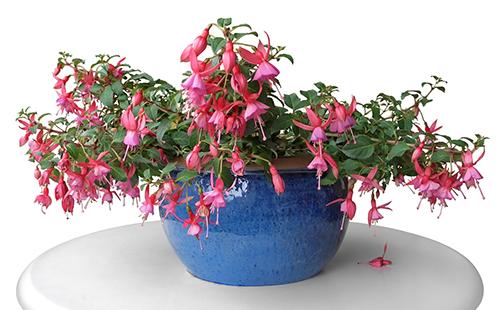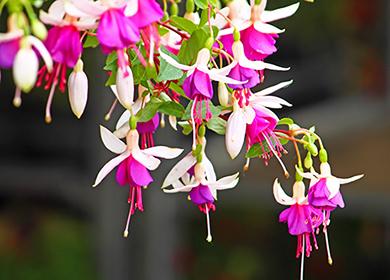The content of the article
In nature, fuchsia is an evergreen perennial culture with many flowers. Botanists have identified 100 species. The plant is found in the form of carpet plantings with small flowers, compact shrubs or trees. There are ampelous varieties.
Description of the plant and which option is suitable for the apartment
The leaves of the plant are green and may have a reddish tint. If you ensure high-quality cultivation of fuchsia at home, then flowering continues from early spring to late autumn. Flowers grow one at a time or in clusters of inflorescences. Corollas have a variety of colors: cream, pink, purple, white, and can also be two-tone or three-color.
There are a huge number of plant varieties. The necessary variety is selected depending on the lighting in the room and the microclimate. For beginners, these four varieties are suitable.
- "Andromeda". Vigorous and bush plant with simple flowers of a red shade. The variety is remarkably rooted, has a good winter and gives lush flowering.
- Anabel. The height of the bush is up to 60 cm. The plant has double and voluminous flowers of white color, and the cuttings are easily rooted.
- Blue frels. A highly branched and abundantly flowering variety. It will please the hosts with purple-pink buds.
- Hollis Beauty. The peculiarity of the plant is terry corollas of white-pink shades.
How to organize care for fuchsia
The flower blooms for a long time and abundantly, but for this you need to create favorable conditions and know how to care for fuchsia. The optimal microclimate will provide the following factors.
- Lighting. Bright but diffused sunlight is suitable for the plant. Soft rays are especially useful in the morning and evening hours, so it is better to choose window sills in rooms on the western and eastern sides.
- Temperature. The optimum plant content is 18 ° C to 25 ° C. The room must be aired.
- Moisturizing. During the flowering period, spraying with a sprayer is required for the plant. The procedure is performed in the morning and evening.
"Housewarming"
Experienced gardeners do not recommend replanting the plant in large dishes. Pots should be sized so that the root system completely fills the container. The time of “housewarming” comes when the roots are clearly visible from the drainage holes or the earth dries instantly after watering.
Before planting a bush, it must be prepared for this procedure:
- stimulating pruning is carried out - old and dry shoots are removed, and the rest are shortened by a third;
- the root system is examined for rot and disease;
- a drainage layer is laid, which should fill the fifth part of the pot.

Pruning
There are various ways to form fuchsia. The easiest option is cropping. The procedure provides magnificent flowering and proper development. You can attach the plant after rooting the cuttings. If there is a peduncle on a young shoot, it should be removed. Regular pruning is performed in the spring, before flowering begins. To form a beautiful crown, it is necessary to cut off the side shoots above every third or fourth pair of leaves.
Water treatments and recharge
Fuchsia needs moderate watering. In the summer, control that the earth is wet, but stagnation is strictly contraindicated. Since September, the schedule of water procedures has been reduced: no more than once or twice a month.
As for top dressing, in spring and summer it should be regular: once every two weeks. Complex fertilizer is used. With the onset of cold weather and a dormant period, it is no longer necessary to fertilize the flower.
Culture propagation
The most commonly used propagation of fuchsia is by cuttings and seeds. The latter method is more laborious. Seeds are planted in small containers. But they do not need to be buried, but only spread on top of the moistened soil substrate. The seed pots are placed in a warm and bright place. Shoots appear in 12-15 days. Picking is carried out a month and a half after planting, and two months later the seedlings are transplanted into separate pots.
Autumn and spring are the right time for cuttings. The procedure consists of four stages.
- A healthy shoot is taken from the bottom of the main stem (up to 10 cm).
- On the handle, the lower leaves are removed.
- The tip of the handle is placed in water or poured sand.
- Two to three weeks later, when small roots appear, the cuttings are planted in pots.
Reasons for no flowers
The best way to make fuchsia bloom at home is to find out the reasons for the lack of flowers. Here are the main ones:
- lack of nutrients;
- excessive watering;
- incorrect temperature (especially if it is too hot and dry in winter);
- lack of lighting;
- wrong pot size.
What is sick
In a healthy plant, the leaves have a rich and healthy color. If fuchsia discards leaves, they dry and become stained - then this is a sure sign of the disease. Take a closer look at the plant and it will tell you what the cause of the disease is.
- Powdery spots. A sign of powdery mildew that appears with excess moisture. From the disease, the plant is treated with Topaz and Fundazol.
- Dryness and yellowness. If the leaves dry, then this indicates chlorosis. To defeat the disease, watering with a solution of manganese is used.
- Brown spots. Rusty areas are removed, and then the plant is sprayed with Bordeaux fluid.
If you know how to care for fuchsia during flowering and follow all the rules of cultivation, your home greenhouse will be decorated with an incredible flower, which is popularly called "gypsy earrings".

